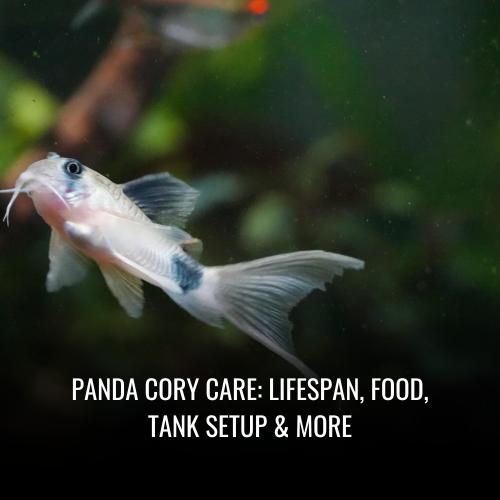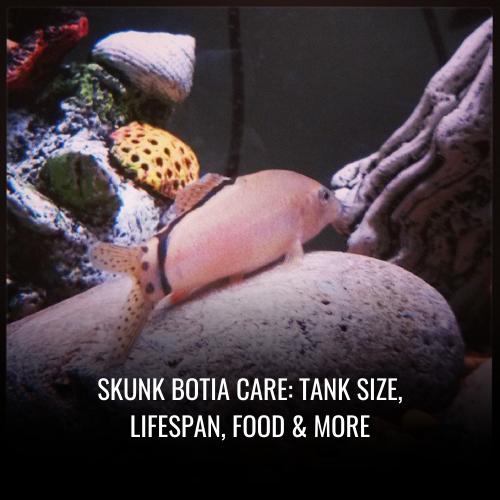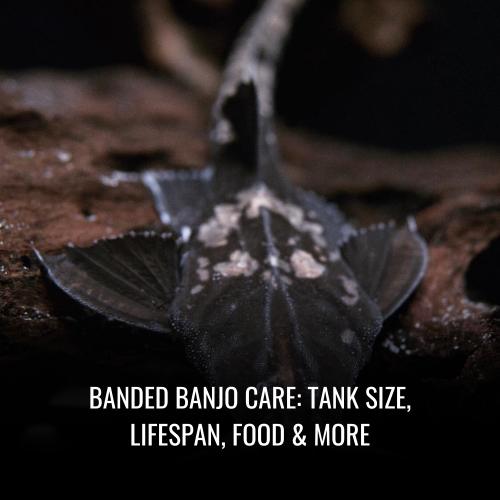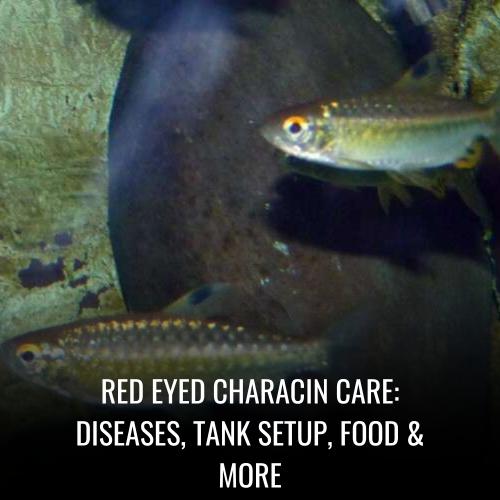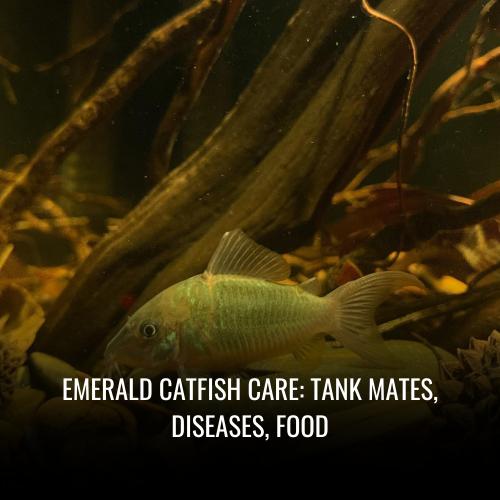Marbled headstander Care: Tank Mates, Size, Diet & Setup
This post contains affiliate links. As an Amazon Associate, we earn from qualifying purchases.
The Marbled headstander, with its striking features and unique behaviors, is an intriguing species native to the varied aquatic landscapes of South America. This herbivorous fish, scientifically known as Abramites hypselonotus, is distinguished by its diamond-shaped body and ability to maintain a head-down stance while swimming. Often found in the river basins of the Amazon, Orinoco, Paraguay, and lower Parana River, the Marbled headstander thrives in environments where plant matter is plentiful.
| Attribute | Information |
|---|---|
| Scientific name | Semaprochilodus taeniurus |
| Common name | Marbled Headstander |
| Family | Prochilodontidae |
| Usual size in fish tanks | Up to 10 inches |
| Recommended pH range | 6.5 – 7.5 |
| Recommended water hardness | 2-18 dGH |
| Recommended temperature | 73-82°F (23-28°C) |
| Reproduction | Egg scatterers |
| Origin | South America, Amazon basin |
| Temperament to own species | Peaceful |
| Temperament to other fish | Peaceful, may become skittish |
| Usual place in the tank | Middle to bottom |
| Lifespan | 5-8 years |
| Tank size requirement | Minimum 55 gallons |
| Filtration system | Efficient filtration needed |
| Sexual dimorphism | Males may be more colorful |
| Substrate cleaning | Requires good waste removal |
Scientific Name
The Marbled headstander is officially classified under the scientific name Abramites hypselonotus. You might also encounter this species under the synonyms Abramites microcephalus, Abramites hypselonotus hypselonotus, Abramites Hypselonotus Ternetzi, or Abramites Solarii, highlighting the fish’s diverse representation across its native South American habitats.
Average Size
In home aquariums, the Marbled headstander typically reaches an average size of 6 inches, with some specimens growing as large as 8 inches. These sizes are reflective of the lengths they achieve in their natural surroundings, allowing them to elegantly navigate their environment.
Lifespan
Provided with optimal care within an appropriate aquarium setup, the Marbled headstander can enjoy a fairly long life. On average, these fish live for about 10 years, but certain individuals have been known to reach 15 years, testament to their resilience and the importance of their captive conditions.
Natural Habitat
The natural habitat of the Marbled headstander spans the extensive river systems of South America, where they are typically found in the main channels and calmer tributaries. Their adaptable nature leads them to areas with ample plant cover, which is essential not just for food but also for shelter.
During the rainy season, these fish demonstrate their capacity to navigate newly submerged territories, showing a fascinating aspect of their life cycle. In rocky stretches of rivers, their behavior allows them to adeptly manage the stronger currents, a testament to the species’ incredible versatility.
Appearance
The Marbled headstander is a stunning South American fish known for its distinct, high-backed, diamond-shaped body that creates an eye-catching silhouette in the water. Its size is notable, as adults can grow to an impressive 8 inches in length. This species flaunts a captivating color scheme, with brown bands running along the body’s length, set against a comparatively lighter background, accentuating its unique form.
One of the most striking features is the dark caudal peduncle, which stands out vividly, adding depth to the fish’s overall appearance. The interplay of light and shadow across their form enhances their sleek look, mirroring the dappled sunlight of their natural riverine habitats.
| Feature | Description |
|---|---|
| Body Shape | Diamond-shaped with a high-backed, deeper body |
| Size | Up to 8 inches in length |
| Coloration | Brown bands on a light background, dark caudal peduncle |
| Visual Appeal | Elongated body and intricate markings |
Behavior & Temperament
Marbled headstanders possess a complex set of behaviors and temperaments that vary with age and environment, making them an intriguing species for aquarium enthusiasts. Understanding their behavioral patterns is crucial to ensuring a harmonious aquatic community and a healthy life for these fish.
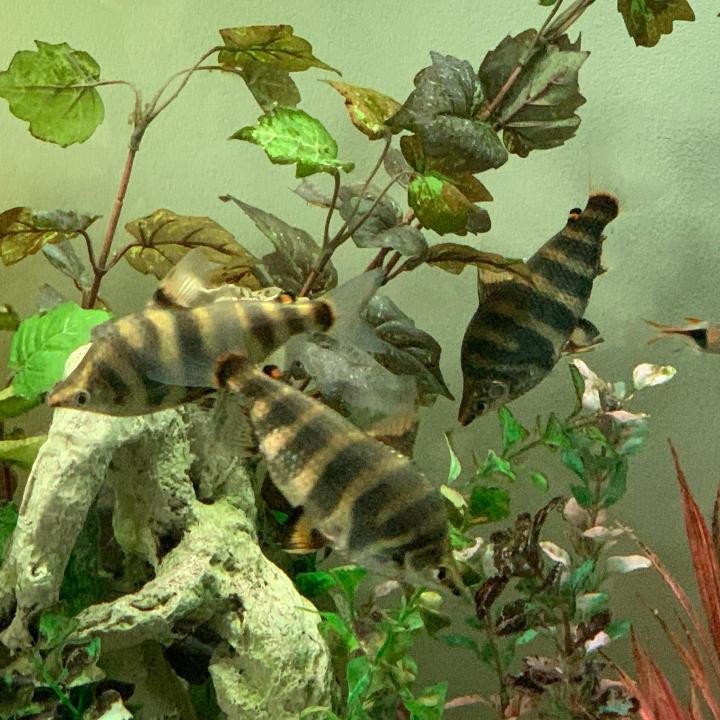
Are Marbled Headstanders Fin Nippers?
Concerns often arise over whether Marbled headstanders are prone to fin nipping behavior. In certain conditions, particularly when stressed, they may exhibit this tendency—usually as a response to crowding or inadequate tank setup. Nonetheless, this behavior is not typically characteristic of the species, and providing a well-structured environment can help reduce such instances.
Are Marbled Headstanders Aggressive To Each Other & Other Fish?
Marbled headstanders can show varying levels of aggression, most notably as they mature. Younger fish often present sociable and peaceful demeanors, living comfortably with other non-aggressive species.
However, territorial inclinations may become more pronounced during their adulthood, especially during the breeding season or when competing for resources. Ensuring a spacious tank with plenty of hiding spots can mitigate aggressive tendencies.
Are Marbled Headstanders Friendly To Each Other & Other Fish?
While juvenile Marbled headstanders may demonstrate social behaviors, such as shoaling, this friendliness often dissipates with age. A transition from a gregarious to a more solitary nature is typical. When paired with compatible tankmates of similar size and temperament, like barbs or larger tetras, Marbled headstanders can coexist peacefully, highlighting the importance of careful species selection for community tanks.
Are Marbled Headstanders Schooling Fish?
Initially, Marbled headstanders exhibit schooling behavior, which provides security and comfort when they are young. As they grow older, they tend to adopt a more solitary lifestyle. Larger groups might disperse aggressive behavior and maintain peace, but it’s essential to consider that individual fish may still choose to keep to themselves despite being part of a group.
Can You Have Just One Marbled Headstander In The Tank?
Given their shift towards solitary behavior as they mature, opting to keep a single Marbled headstander in an aquarium could avoid conflicts inherent to their territorial nature. This choice would prevent the emergence of dominant individuals that might harm others, ensuring a stress-free environment for the fish and a more tranquil tank overall.
Do Marbled Headstanders Need To Be In Groups?
The necessity for Marbled headstanders to reside in groups largely depends on their age and the aquarium’s conditions. While young fish benefit from the camaraderie of a group, older individuals may favor a more independent existence.
Providing an abundance of plant matter and room to explore can contribute to harmonious group dynamics during their juvenile phase. In contrast, ample space and privacy become more critical as they age.
Food & Diet
Marbled headstanders have established themselves as fascinating additions to the aquarium due to their unique dietary preferences and behaviors. This South American species thrives on a primarily herbivorous diet, but also enjoys a variety of supplemental foods, which can enhance their health and vibrancy.
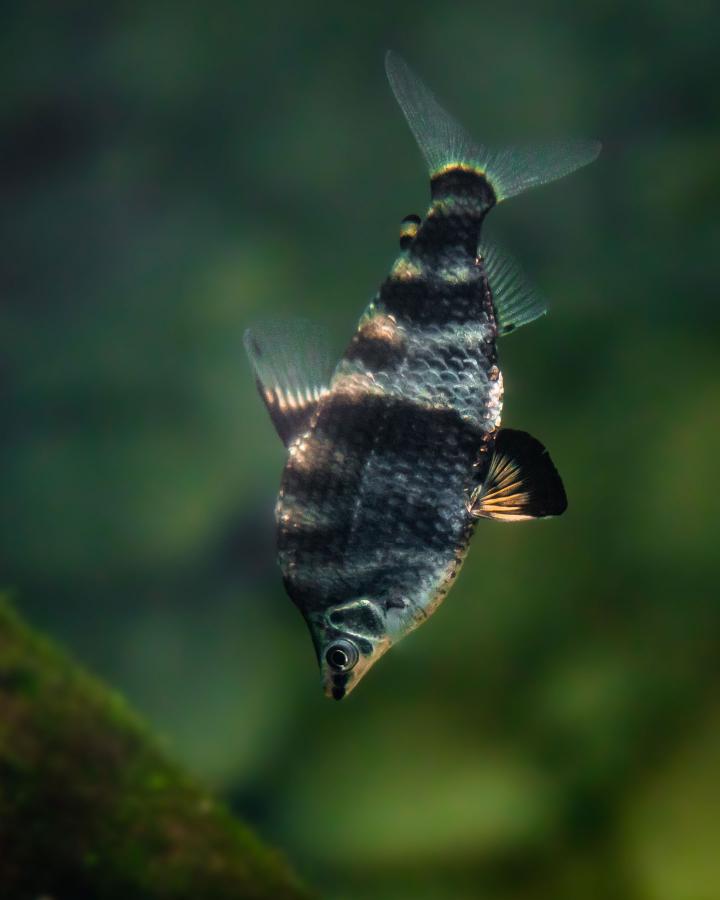
Do Marbled Headstanders Eat Algae?
Yes, Marbled headstanders are known to graze on algae and biofilm that accumulate on tank surfaces, showcasing their herbivorous nature. These fish are often seen scouring the tank, feeding on the greenery that forms, which can help to manage algae levels. While they can play a role in controlling algae, it’s important to provide a balanced diet that includes fresh vegetables and specialized food formulations to meet their nutritional needs fully.
Do Marbled Headstanders Eat Shrimp?
In a community aquarium, Marbled headstanders may consume small shrimp, especially if they fit within their mouth’s reach. While they do not exclusively hunt for shrimp, their opportunistic feeding habits mean shrimp could become unintended prey. It is advisable to pair them with tankmates of comparable size to avoid potential predation issues.
Do Marbled Headstanders Eat Bloodworms?
Marbled headstanders may partake in bloodworms as an occasional treat rather than a staple of their diet. Their menus should be filled predominantly with vegetable-based items like de-shelled peas, lettuce, and herbivore flakes to ensure proper digestion and health. A controlled serving of bloodworms can add nutritional variety, but moderation is key to keeping Marbled headstanders in top condition.
Do Marbled Headstanders Eat Mosquito Larvae?
Yes, these omnivorous fish may include mosquito larvae in their diet. While they primarily feast on plant matter, the larvae can offer essential nutrients and variety to their meals. In the wild, such protein-rich supplements are a natural part of their diet, especially in the diverse ecosystems of the Parana and Orinoco river basins. Mimicking this aspect of their natural diet can enrich their in-captivity lives.
Do Marbled Headstanders Eat Planaria?
While the majority of their diet is plant-based, Marbled headstanders might also feed on small invertebrates like planaria within their environment. This illustrates their adaptability and foraging behavior, suggesting that they benefit from diverse food sources, which should include both their favored greens and occasional live or frozen small invertebrates.
Do Marbled Headstanders Eat Plants?
Marbled headstanders are prone to nibbling on soft aquarium plants due to their herbivorous preferences. To prevent them from demolishing prized botanicals, it is recommended to offer abundant fresh vegetables and specialized herbivore flakes.
Incorporating hardy plants that can withstand a bit of grazing and providing root-like driftwood can secure both the Marbled headstanders’ dietary satisfaction and the aesthetic integrity of your planted tank.
Below is the table summarizing their dietary habits:
| Dietary Item | Consumption Frequency | Notes |
|---|---|---|
| Algae | Regularly | Helps control algae in the tank but should not substitute a balanced diet |
| Shrimp | Opportunistically | Potential predation risk for small shrimp varieties |
| Bloodworms | Occasionally | Should be minimized to avoid digestive issues |
| Mosquito Larvae | Occasionally | Serves as a natural protein supplement |
| Planaria | Occasionally | Can be included as part of a diverse diet |
| Aquarium Plants | Opportunistically | Adding plant-based foods could prevent damage to live plants |
Sexing: Male vs Female
Distinguishing between male and female Marbled headstanders, scientifically known as Abramites hypselonotus, is essential for hobbyists looking to understand the dynamics of their aquarium population. The species exhibits sexual dimorphism, particularly in body shape, which becomes evident as the fish mature.
Mature females are distinguishable by their deeper bodies, characterized by a more rounded and fuller appearance, especially when observed from the side. This contrast is stark against the males, who present a slimmer and more streamlined profile. As Marbled headstanders grow in size and reach sexual maturity, these differences become even more pronounced.
Viewed from above, this disparity is also noticeable with females showcasing a wider and more robust build relative to the males. Using body shape as a visual cue provides a reliable method for sexing these fish within the aquatic setting.
| Sex of Marbled Headstander | Body Shape Characteristics |
|---|---|
| Female | Deeper, rounded, fuller body shape; noticeably wider when viewed from above |
| Male | Slimmer, more streamlined body shape; less girth compared to females |
In conclusion, sexual dimorphism in the Marbled headstander can be identified successfully through careful observation, enabling aquarists to sex their fish correctly.
Marbled headstander Tank Mates
Marbled headstanders, hailing from river basins in South America such as Orinoco, Amazon, Paraguay, and Paraná, are herbivorous fish that can share their aquarium with a variety of similar-sized species. During their juvenile phase, they exhibit sociable tendencies, yet they lean towards solitude as they age, showing less tolerance for their kind.
Aquarists should exercise caution, especially with small fish, due to potential aggression from maturing Marbled headstanders. A well-thought community tank might include large Amazonian characids, peaceful cichlids, barbs, larger tetras, or rainbowfish. Such company ensures companionship without triggering the headstander’s territorial instincts.
To replicate their natural habitat, provide hiding spots through wood and robust aquarium plants. Marbled headstanders have been known to snack on delicate plants and algae, so it’s important to keep the tank equipped with hardy plants or offer green dietary supplements.
| Tank Mates Ideal for Marbled Headstander | Compatibility Notes |
|---|---|
| Large Amazonian Characids | Require similar environmental conditions |
| Peaceful Cichlids | Size and temperament match the headstander’s needs |
| Barbs, Larger Tetras, Rainbowfish | Friendly species that can handle occasional nipping |
| Hardy Plants, Wood | Provides hiding spots and mimics natural habitats |
Creating a suitable environment with proper tank mates will ensure your Marbled headstanders grow healthy and interact well within their aquatic community.
Aquarium Setup
Creating a proper aquarium setup for Marbled headstanders is crucial to ensure they thrive in captivity. These fascinating fish, noted for their unique positioning at a head-down angle, come from various river basins in South America and require an environment that reflects their natural habitat.
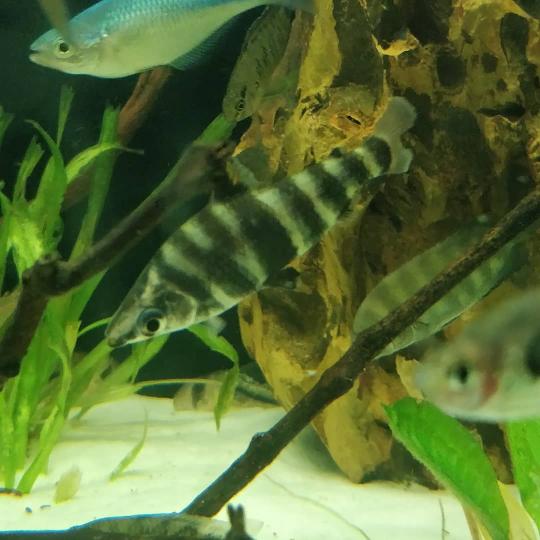
Ideal Tank Size
Marbled headstanders are active and relatively large, requiring plenty of space to roam and exhibit natural behaviors. A tank of at least 55 gallons (around 120 centimeters in length) is the minimum recommended size for a single individual. However, for a group setting that emulates their schooling nature, a larger tank is necessary. The spacious environment not only allows for adequate swimming space but also accommodates decor and plants, contributing to a balanced ecosystem and reducing conflicts among tank inhabitants.
| Minimum Tank Size | Group Setting Tank Size | Benefits |
|---|---|---|
| 55 gallons | Larger than 55 gallons | Ample swimming space, room for tank mates, environmental enrichment, stable water quality |
Ideal Water Parameters
Marbled headstanders favor slightly acidic water with a pH ranging from 5.5 to 7.5, a temperature between 73°F to 82°F (23°C to 28°C), and a general hardness (GH) from 2 to 15. To maintain these conditions, a reliable filtration system combined with regular water changes is essential. The diligent management of water parameters ensures a stress-reduced environment conducive to the health and longevity of these herbivorous fish.
| Water Parameter | Ideal Range | Importance |
|---|---|---|
| pH | 5.5 to 7.5 | Simulates natural acidic conditions |
| Temperature | 73°F to 82°F (23°C to 28°C) | Keeps Marbled headstanders comfortable |
| General Hardness (GH) | 2 to 15 | Matches the native water hardness of South American rivers |
Filtration
An efficient filtration system is imperative for Marbled headstanders due to their plant-heavy diet and resulting high bioload. Canister or sump filters are recommended, as they adequately handle the biological, mechanical, and chemical filtration necessary for sustaining water quality. The preference of Marbled headstanders for well-oxygenated water suggests a need for a filter with moderate to strong water flow. Regular maintenance of the filtration system is also key to prevent the accumulation of waste and to promote a healthy living environment.
Lighting
The lighting within a Marbled headstander’s aquarium should imitate the dappled sunlight of their native, shaded rivers. It’s advisable to provide areas of lower intensity or shaded spots, using plant cover or decorations to diffuse light and offer reprieve.
LED lights are preferred for their adjustability in intensity and color, ensuring you can create conditions similar to the subdued light of the South American rivers. The goal is to maintain a balance in lighting that prevents algae bloom while also keeping the Marbled headstanders stress-free, promoting natural behaviors and cycles.
Remember, the success of an aquarium hinges on replicating the natural conditions as closely as possible, allowing Marbled headstanders and their tank mates to flourish. With careful consideration of tank size, water parameters, filtration, and lighting, you can create a healthy and visually stunning underwater world for these remarkable fish.
Common Possible Diseases & Prevention
Marbled headstanders, while a robust species, can fall prey to ailments common to freshwater fish. Issues like Ich, fin rot, and parasitic infections can afflict these South American natives. To safeguard them, certain prevention tactics are indispensable.
Firstly, upholding high water quality is non-negotiable. This includes precise, regular water changes that help deter disease. Another pillar of prevention is providing a varied, balanced diet to strengthen the fish’s immune system.
Isolating new additions in a quarantine tank before they join the main display is crucial in preventing the introduction and spread of potential diseases. Marbled headstanders are also stress-sensitive, making a tranquil and stable aquarium environment vital for their well-being.
Regular monitoring for symptoms of illness or unusual behavior is key. Prompt detection allows for swift intervention, ensuring better outcomes for the affected fish.
| Disease Prevention Measures | Description |
|---|---|
| Maintain water quality | Perform consistent water changes and monitor parameters to prevent disease occurrence. |
| Balanced diet | Feed a variety of foods to enhance the immune system. |
| Quarantine new fish | Keep newcomers separate to avoid spreading diseases to established residents. |
| Stable environment | Minimize stress by ensuring a peaceful tank setup with plenty of hiding spaces. |
| Regular observation | Watch for any signs of ill health for early disease detection and treatment. |
By adhering to these guidelines, Marbled headstanders can enjoy a healthy life in your aquarium.
Breeding Marbled headstander In Aquarium
Breeding Marbled headstanders in a home aquarium setting remains an enigma for aquarists worldwide. The intricate process has not seen success, likely due to the cryptic sexual dimorphism of the species. Mature females typically show a slightly fuller figure than their male counterparts—an elusive clue for breeders to discern gender.
A spacious tank of 500 liters or more is necessary to cater to their needs, accentuated by a preferred light water current, mimicking the natural flow of their South American river habitats. However, maintaining an environment conducive to their breeding, particularly with live plants, proves futile. Their voracious appetite for plant matter means that any attempt to cultivate a lush, planted aquarium would be met with vegetation being devoured.
As juveniles, Marbled headstanders exhibit a degree of sociability, thriving alongside similar biotope species. Yet, with maturity comes solitude and a propensity for aggression, complicating breeding conditions, as even conspecifics are not spared from their territorial assertions.
| Aquarium Specifications | Requirements |
|---|---|
| Tank Size | Minimum 500 liters |
| Water Flow | Light surface current |
| Plant Compatibility | Not suitable for live plants |
| Cohabitation in Juveniles | Possible with similar species |
| Behavior in Adulthood | Solitary and potentially aggressive |
Understanding and adapting to these demands is critical, as the quest for breeding Marbled headstanders continues.
Are Marbled headstander Easy To Keep?
Maintaining Marbled headstanders can be a challenging yet rewarding endeavor for the discerning aquarist. These unique South American fish are marked by their distinct swimming posture — head tilted downward as they scour for food. Despite their peaceful demeanor, Marbled headstanders exhibit territorial aggression towards each other with maturity, making it crucial to manage their living conditions carefully.
For aquarists seeking to create an ideal environment for Marbled headstanders, a large 500-liter tank is non-negotiable. This size accommodates their full-grown stature and helps mitigate aggressive behavior. The addition of root-like driftwood offers essential hiding spaces, fostering a sense of security.
Unfortunately for plant enthusiasts, these herbivorous fish are incompatible with planted aquariums due to their appetite for aquatic vegetation, stripping the tank bare of most flora. Marbled headstanders do, however, enjoy a varied diet of fresh vegetables like cucumber, lettuce, and de-shelled peas, as well as specially formulated herbivore flakes and small live foods.
| Requirement | Detail |
|---|---|
| Minimum Tank Size | 500 liters |
| Dietary Needs | Fresh vegetables, herbivore flakes, small live foods |
| Aggression with Maturation | Can become territorial |
| Plant Compatibility | Not suitable for live plants |
| Tank Decor | Root-like driftwood for hiding |
Are Marbled headstander Sensitive To Water Changes?
Marbled headstanders’ health is closely intertwined with the quality of water in which they reside. They demonstrate a clear sensitivity to sudden changes in water parameters such as temperature and pH. These abrupt shifts can cause severe stress, weakening their immune systems and elevating the risk of disease and infection.
An unwavering approach to maintaining water stability is key. Aquarists must carefully acclimate Marbled headstanders when introducing them to new tank conditions or conducting water changes, easing them into alterations to avoid causing undue stress.
Are Marbled headstander Sensitive To Ammonia?
Marbled headstanders, accustomed to the pristine waters of their native river channels, have a low tolerance for impurities such as ammonia. Elevated ammonia levels can wreak havoc on their delicate gill tissues and impair respiratory functions, leading to significant distress.
Even minimal ammonia exposure can have detrimental effects, manifested as heightened stress and altered behavior. Ensuring the well-being of Marbled headstanders involves stringent water testing and rigorous maintenance to keep ammonia at bay. This vigilance is crucial for sustaining their long-term health in an aquarium setting.
Are Marbled headstander Sensitive To Copper?
Copper’s presence in an aquarium, albeit microscopic, can pose a toxic threat to the delicate balance of Marbled headstander’s health. They exhibit a particularly low tolerance to the metal, which can lead to gill function disruption and respiratory problems. The metal might seep into the tank environment from various sources, including tap water additives, decorations, or equipment, demanding an acute awareness from the fish keeper.
Aquarists are advised to use copper-free water resources and avoid decorations and treatments containing copper. Regular water tests should be conducted to ensure a copper-free habitat, promoting a healthy and stress-free living environment for Marbled headstanders.

